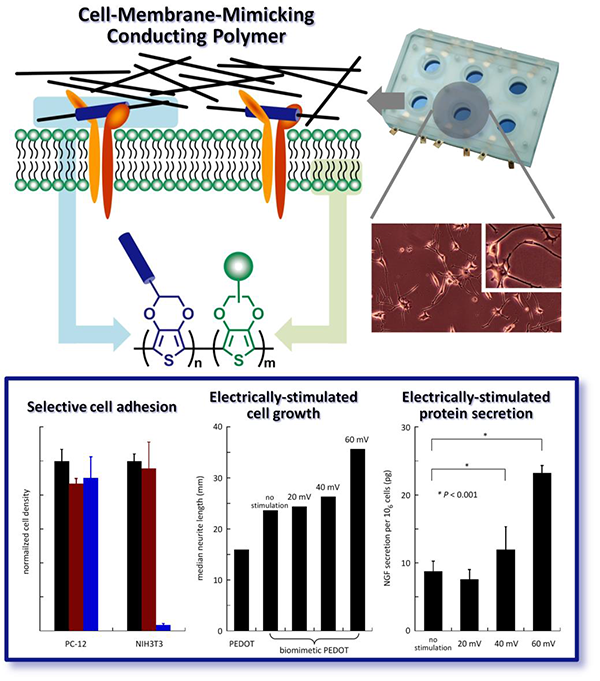中央研究院化學研究所-學術研究
仿細胞膜導電高分子及其於電刺激細胞工程上的應用
Large Enhancement in Neurite Outgrowth on a Cell-Membrane-Mimicking Conducting PolymerNature Communications. 2014, 5, 4523.
Bo Zhu, Shyh-Chyang Luo, Haichao Zhao, Hsing-An Lin, Jun Sekine, Aiko Nakao, Chi Chen, Yoshiro Yamashita, Hsiao-hua Yu.*
利用生物電子元件來進行電刺激神經細胞的生長是一個在再生醫學上很有潛力的研究方向。然而,免疫系統的防衛機制會隔離殖入電極,從而降低了裝置的壽命。理想的生物機電介面的電極材料,不但能夠應該與神經元有選擇性且能高效率地結合之外,並且應該要能盡量減少免疫系統的防衛效應,這在實際應用上相當中重要的。在本論文中,藉由模仿生物細胞膜的功能與分子結構,我們開發了適合生物機電介面電極的新穎導電高分子以及用其組成的奈米薄膜。這種新型的導電高分子奈米薄膜,不但具有高的生物相容性、高水溶液穩定性,同時可以抵擋非專一性的蛋白質以及細胞的吸附,從而辨認和促進與目標細胞的長時間電信號連通。這種材料也具有低電阻抗,可以有效傳遞電訊號並產生生物刺激。藉由這型新穎的材料,我們建構了先進的奈米生物電子界面,並在此界面上利用電刺激的方式,讓神經突觸的增生得到了破紀錄的增強,大幅地提高了神經細胞的分化及成長效率。相同的奈米生物電子界面,也同時運用在利用電流刺激增加蛋白質的分泌的研究以及應用上。
Although electrically stimulated neurite outgrowth on bioelectronic devices is a promising means of nerve regeneration, immunogenic scar formation can insulate electrodes from targeted cells and tissues, thereby reducing the lifetime of the device. Ideally, an electrode material capable of electrically interfacing with neurons selectively and efficiently would be integrated without being recognized by the immune system and minimize its response. In this research article, we develop a cell membrane–mimicking conducting polymer possessing several attractive features. This polymer displays high resistance toward nonspecific enzyme/cell binding and recognizes targeted cells specifically to allow intimate electrical communication over long periods of time. Its low electrical impedance relays electrical signals efficiently. This material is capable to integrate biochemical and electrical stimulation to promote neural cellular behavior. Neurite outgrowth is enhanced greatly on this new conducting polymer; in addition, electrically stimulated secretion of proteins from primary Schwann cells can also occur upon it.

